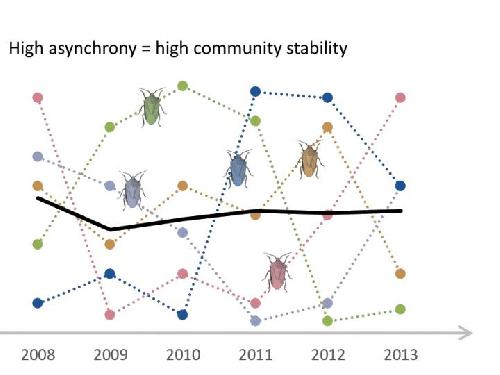Whether an animal or plant community remains stable despite external impacts does not depend on biological diversity alone: asynchrony across the species is also a crucial factor. The more asynchronous the species in an ecosystem fluctuate in their abundances, the less likely it becomes unstable. As a result, diversity takes second place in terms of the factors to be considered in the context of ecosystem stability. A team of scientists spearheaded by the TU Munich and TU Darmstadt have published these findings in the journal Nature Communications.
The long-term functioning of ecosystems depends on the stability of their species communities, as these ensure the functioning of the entire system. However, land use causes a reduction of the number of species in many ecosystems. Accordingly, when it comes to conserving species diversity and providing sustainable protection for natural resources, the stability of such animal and plant communities is the main goal of nature conservation and ecosystem management. In principle, higher species diversity and greater asynchrony can increase the stability of the species community. But if land use is intensified or changed, which of these factors - species diversity or asynchrony - is more important?
 The abundance of species is subject to natural variations (dotted lines). The mean variation of the entire community fluctuates much more if the individual species are synchronous. In contrast, if the abundance of species varies asynchronously, the abundance of the community is very stable. Credit: (Abb.: TUM/ Gossner)
The abundance of species is subject to natural variations (dotted lines). The mean variation of the entire community fluctuates much more if the individual species are synchronous. In contrast, if the abundance of species varies asynchronously, the abundance of the community is very stable. Credit: (Abb.: TUM/ Gossner)
Six-year-plus study on over 2,600 species
For their study, the researchers evaluated over 2,600 species ranging from insects and spiders, to birds and bats and through to herbaceous plants over a period of six years. Data from 150 forests and 150 pastures and meadows located in three regions in Germany were collated. "The results show that a change in the use of a landscape, for example when a managed forest is converted into grassland, destabilizes the animal and plant community," explains Dr. Martin Gossner from the Terrestrial Ecology Research Group at the TU Munich. "Similarly, the intensification of land use results in the destabilization of the animal and plant community and this, in turn, impairs the entire ecosystem," adds Dr. Nadja Simons (also from the TU Munich). Animal communities presented a stronger reaction here than their plant counterparts. The most severe reaction by far was observed among birds and bats, which can therefore be seen as indicators of land-use intensity.
The more asynchronous the species, the more stable the ecosystem
What is new about the insights gained in this study is the extent to which the asynchrony of the species can increase the stable interplay of animals and plants in an ecosystem: "The more asynchronously the species develop and act, the more stable the system," says Prof. Nico Bluethgen from the Department of Biology at TU Darmstadt. "We can compare it to the stock exchange, where risk-averse investors are encouraged not to put all their eggs in one basket and to create a portfolio of different securities instead. This is referred to as the portfolio effect. And, just as in nature, in order to cushion the impact of fluctuations in the investments over time, it is important that the portfolio not only contains a lot of investments but also different types of investments." Asynchrony thus assumes a key role in the interaction between diversity and stability. The scientists plan to investigate the factors that lead to greater asynchrony in further studies.
This joint project by several research groups was the most comprehensive study on the topic of stability to date and was carried out in the context of "Biodiversity Exploratories" research alliance. This alliance is funded by the Deutsche Forschungsgemeinschaft (DFG, German Research Foundation). One of its express aims is to facilitate long-term studies of this kind, as impacts on the stability of ecosystems can only be studied effectively from a long-term perspective.
source: Technical University of Munich (TUM)